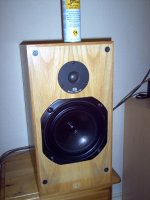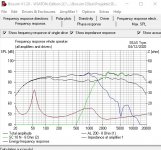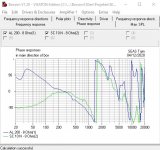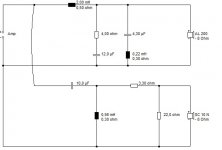The two main issues with an L22 in a 2 way (first is more important):
1. Cone breakup and induced 3rd harmonic distortion ~ 1333Hz (with a ~ 4KHz breakup node as seen in the factory graph)
2. Beaming due to wavelength narrowing to less than the piston diameter - leading to lumpy off-axis response when blended with your tweeter.
I have implemented the L15 and could not take it past 2300Hz (with a 8.1KHz breakup) without hearing the distortion. Especially notable on Cantina by the London Philharmonic. The acoustic guitar had electric guitar distortion.
The notch I ended up using was a series notch (cap and inductor in series) - then paralleled with the driver. This is a bottomless (very high Q) notch to target the massive breakup (+15dB) and bring it down without sagging neighbouring frequencies. By itself - it is possible to calculate at the precise driver impedance at the breakup frequency... however this will be different in practice due to upstream crossover components changing impedance. This is where XO simulation in a tool is a must. Another option is a very small value cap in parallel with the main series inductor (shaping the low pass and bafflestep). Watch impedance with this option too and high frequency "ringing".
I think the W22 could make an excellent woofer in a 3 way system.
I use the L26 with the L15 - crossed at 230Hz. Well away from a similar breakup which is non audible on the L26 and required no notching.
1. Cone breakup and induced 3rd harmonic distortion ~ 1333Hz (with a ~ 4KHz breakup node as seen in the factory graph)
2. Beaming due to wavelength narrowing to less than the piston diameter - leading to lumpy off-axis response when blended with your tweeter.
I have implemented the L15 and could not take it past 2300Hz (with a 8.1KHz breakup) without hearing the distortion. Especially notable on Cantina by the London Philharmonic. The acoustic guitar had electric guitar distortion.
The notch I ended up using was a series notch (cap and inductor in series) - then paralleled with the driver. This is a bottomless (very high Q) notch to target the massive breakup (+15dB) and bring it down without sagging neighbouring frequencies. By itself - it is possible to calculate at the precise driver impedance at the breakup frequency... however this will be different in practice due to upstream crossover components changing impedance. This is where XO simulation in a tool is a must. Another option is a very small value cap in parallel with the main series inductor (shaping the low pass and bafflestep). Watch impedance with this option too and high frequency "ringing".
I think the W22 could make an excellent woofer in a 3 way system.
I use the L26 with the L15 - crossed at 230Hz. Well away from a similar breakup which is non audible on the L26 and required no notching.
I do get a bit cross at people who make things harder than they are.
Likewise, when someone over-simplifies things.
Why measure a driver when SEAS have already done it for you?
Because the Seas measurement is on the IEC standard baffle. Putting the drivers in a real-world cabinet will change the response.
Chris
Well, mr. Gerhard is mystifying things imho. 'Low Q is high energy storage', sure. Energy in the form of heat he probably means. Now that heat is likely to radiate sound. And the disqualification of MLSSA and Clio, the man obviously is ranting or doesn't know his stuff.SpeakerBuilding.com - Interview with Joachim Gerhard of Audio Physic, Page 1
Last edited by a moderator:
I have immense respect for Joachim Gerhard, who is actually not wired up like most of us. Can't say much more. But he earns a living from speakers so can't give everything away for gratis.
Actually, I believe SEAS measure drivers in fairly standard closed boxes in an anechoic chamber. 8" is usually measured in 21L boxes IIRC. They don't do IEC baffles. Put your mouse over the frequency response graph and all is revealed.
E0022-08S W22EX001
Because the Seas measurement is on the IEC standard baffle. Putting the drivers in a real-world cabinet will change the response.
Actually, I believe SEAS measure drivers in fairly standard closed boxes in an anechoic chamber. 8" is usually measured in 21L boxes IIRC. They don't do IEC baffles. Put your mouse over the frequency response graph and all is revealed.
E0022-08S W22EX001
Last edited:
Steve, you are right about the measurements from SEAS. Even the box sizes are given. Nevertheless you should measure in box. And wrt your respect mr. Gerhard, I just commented on the lines in the interview you linked to. The man clearly doesn‘t show the back of his tongue, we say here.
When I started this thread I ( as a novice) was simply asking for advice regarding cover frequency and filter order for a given pair of drivers. A simple request for assistance from people who know a lot more than I do. Now I’m witnessing conflict over who has the biggest pair. I had a poor performing set of home built speakers that I loved until I fed them a better signal. The crossover was cheap using electrolytic capacitors and I’m not even sure the xover was for these drivers. I greatly appreciate all the help offered. I feel my start point is from a xover designed for the drivers I’ll be using. That is leaps ahead of where I was just a few days ago. I readily pay homage to the experience in this field that you all have but despite the debate regarding measurements etc, for me, a man of 58 years who has worked in engineering all my life I think something is being missed here. Isn’t the enjoyment of hifi about the music and the listener. Despite all the formulae, calculations and measurements I am confident that what I will have as I complete my project is music presented many times better than before. If it sounds satisfying to me then I will have achieved what I set out to do. And the music will win.
Last edited:
Ah don't worry, fellow technicians have bad habits of lingering and discussing non relevant details. As you probably can imagine.
Bottom line is that you cannot trust your ears when designing a crossover. And since measurement equipment has become very affordable (I too am from the age of HP Fourier analysers occupying half your workbench, the other half filled with B&K microphone preamps and signal generators), online tutorials widely available and you already spent a lot of money on expensive drivers, you would really do yourself a favor going that road.
Bottom line is that you cannot trust your ears when designing a crossover. And since measurement equipment has become very affordable (I too am from the age of HP Fourier analysers occupying half your workbench, the other half filled with B&K microphone preamps and signal generators), online tutorials widely available and you already spent a lot of money on expensive drivers, you would really do yourself a favor going that road.
Joachim Gerhard is a regular forum contributor. I always listen to him. Have heard some of his Mangar speakers with Scan Woofers, and they are astonishingly undistorted. See he is interested in distortion. Any fool can get frequency response flat, but it doesn't tell you everything.
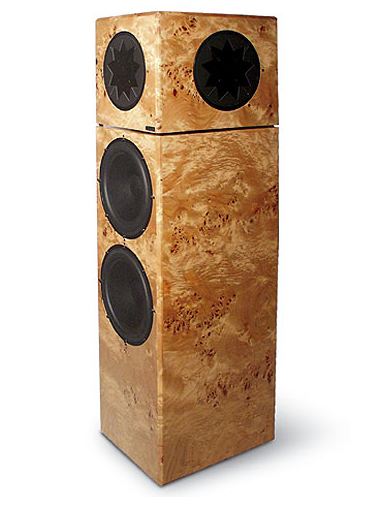
Different, eh? Some more regular designs here: Sonics by Joachim Gerhard cabinets and kits.
He is quite interested in ferrofluid. Is it a good thing? I took mine out after reading his ideas. Sounds better IMO, but I use 4th. order tweeter crossovers, which are more forgiving. The first image.
Anyhow, ran the old Visaton Boxsim up the flagpole with similar drivers to the SEAS TRYM. If you use the T35 tweeter instead of the T25, you just change the 3.3R/22R attenuator to 5.6R on both legs. Seems to give 6dB attenuation. Curiously the notch wasn't quite where I expected it to be. But SEAS know what they are doing.
Different, eh? Some more regular designs here: Sonics by Joachim Gerhard cabinets and kits.
He is quite interested in ferrofluid. Is it a good thing? I took mine out after reading his ideas. Sounds better IMO, but I use 4th. order tweeter crossovers, which are more forgiving. The first image.
Anyhow, ran the old Visaton Boxsim up the flagpole with similar drivers to the SEAS TRYM. If you use the T35 tweeter instead of the T25, you just change the 3.3R/22R attenuator to 5.6R on both legs. Seems to give 6dB attenuation. Curiously the notch wasn't quite where I expected it to be. But SEAS know what they are doing.
Attachments
The discussions will no doubt continue, but it is at this stage that the majority of first time posters bow out, content that their question has been answered to their satisfaction.If it sounds satisfying to me then I will have achieved what I set out to do.
The cut and thrust is enough to make a man from Troon swoon!
Too true. Sometimes you find it on the second go around, sometimes you find it on someone elses thread.
You seem willing to jump to a solution and we take that into account. The totality of crossover knowledge will not fit into a post so there is always a struggle to find and stay on topic. Taken out of context it is often going to look like incomplete information.
I've been uncertain about your real concerns. What happens when you cross the tweeter low? the woofer high? does it matter when using an off the shelf crossover? how far you want to go?
You seem willing to jump to a solution and we take that into account. The totality of crossover knowledge will not fit into a post so there is always a struggle to find and stay on topic. Taken out of context it is often going to look like incomplete information.
I've been uncertain about your real concerns. What happens when you cross the tweeter low? the woofer high? does it matter when using an off the shelf crossover? how far you want to go?
I'll put my 2c worth in on why I think you will see so many different oppinions on the same thing.
Firstly my feeling is that everyone has different tolerances to different types of flaws in speaker systems. There is no such thing as a perfect speaker, you have to pick your tradeoffs. What may drive one person mad, may not bother another person at all, hence you will see arguments over whether something is important or not.
Secondly as has been alluded to, doing measurements properly is difficult, and it is hard to know whether you have done them properly or not. I suspect a great many people who don't trust measurements because they have heard systems (or even done them themselves) that were created based on flawed measurements. It could also be that the creator of these systems chose different priorities to what the listener would (as in point one above).
Lastly our ears / brains get used to a certain sound. Even if that sound is flawed, it sounds right to us. When we hear something significantly different to that "normal" sound, we think it is wrong. Something that Earl Geddes told me long ago was to not fall for the trap of tweaking the system to sound "right" straight away. Trust the measurements even if they sound wrong, and listen to it for at least a few weeks before making the decision to change anything. If it still sounds wrong after a period of time then fine, but if it no longer sounds wrong your brain has probably re-adjusted to the more correct sound. If you go back to the original, it will probably now sound wrong.
Tony.
Firstly my feeling is that everyone has different tolerances to different types of flaws in speaker systems. There is no such thing as a perfect speaker, you have to pick your tradeoffs. What may drive one person mad, may not bother another person at all, hence you will see arguments over whether something is important or not.
Secondly as has been alluded to, doing measurements properly is difficult, and it is hard to know whether you have done them properly or not. I suspect a great many people who don't trust measurements because they have heard systems (or even done them themselves) that were created based on flawed measurements. It could also be that the creator of these systems chose different priorities to what the listener would (as in point one above).
Lastly our ears / brains get used to a certain sound. Even if that sound is flawed, it sounds right to us. When we hear something significantly different to that "normal" sound, we think it is wrong. Something that Earl Geddes told me long ago was to not fall for the trap of tweaking the system to sound "right" straight away. Trust the measurements even if they sound wrong, and listen to it for at least a few weeks before making the decision to change anything. If it still sounds wrong after a period of time then fine, but if it no longer sounds wrong your brain has probably re-adjusted to the more correct sound. If you go back to the original, it will probably now sound wrong.
Tony.
I'm not bowing out. As far a measuring goes I'm not sure I'd understand what they were telling me or what to do about them. I've chosen to START with a crossover already designed by a speaker designer with the same drive units. I am aware that my cabinet is different and that my room acoustics will influence what I hear. I am coming from a start point where my speaker cabinets have had 2 driver installations and the crossover I suspect was from the first set. It is a cheap build using Wilmslow Audio Electrolytic capacitors etc. I thought they sounded good (I was happy) until I changed my whole system. Nothing high end but about as good as I will have. I refer to my Roksan Caspian amp and CD player and my Cambridge media player. Chord Shawline interconnects including XLR and double runs of Shawline cable to the speakers. This soon revealed to me the quality of my speakers. I have Morel MDT30S tweeters which I understand are middle of the road so they are going. Considering the crossover uncertainty and the tweeter I really don't think I can do worse. As I tried to express before here I'm never going to understand all the technicalities of design but I will know when what i'm hearing pleases me. When I'm listening, it's the music I'm thinking of not whether or not there's something not right. I fully respect all of the opinions offered to me here and bow to your obvious technical experience, without which I wouldn't even have my start point. I will measure my speakers after the build somehow and if I identify a niggle I will not hesitate to tell you on this forum what it is and to ask for advice on a fix. Tweaking a crossover won't be an issue and I'll get to MY heaven eventually.
Last edited:
There's a tremendous joke in this brief clip from BBC comedy show "Mongrels":
Guide Dog Training - Mongrels - BBC Three - YouTube
"So my young Protege, you wish learn the ancient Art of crossovery..."
Wearisome measuring follows...
"WAIT. So really, all I need is ears!"
"Welcome aboard!"
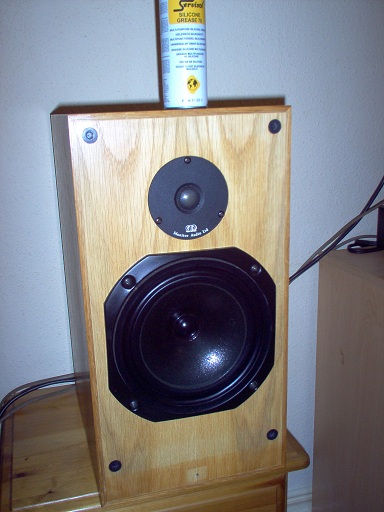
Original circuit:
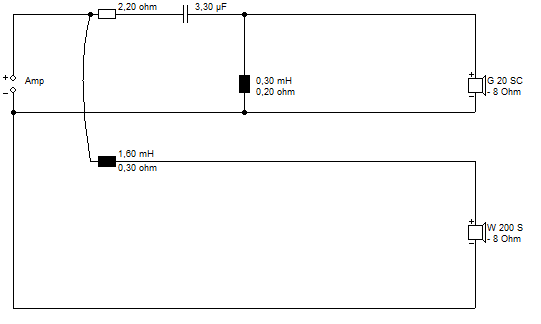
One of my more demented efforts:
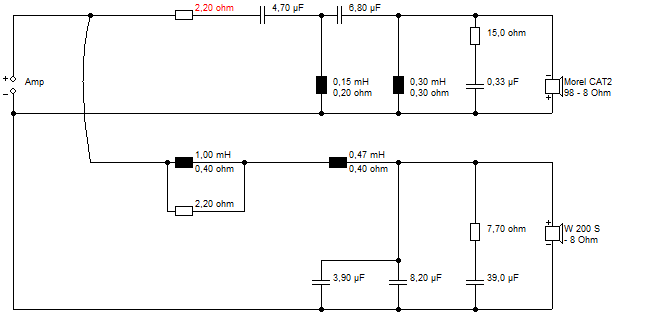
And another one:
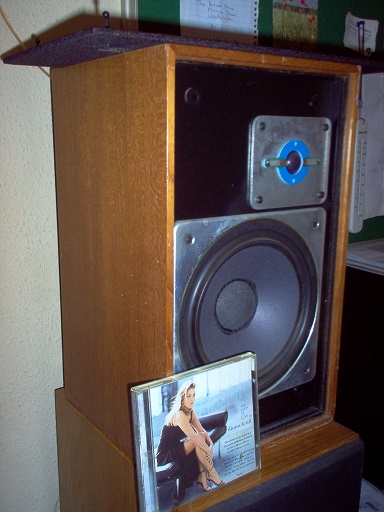
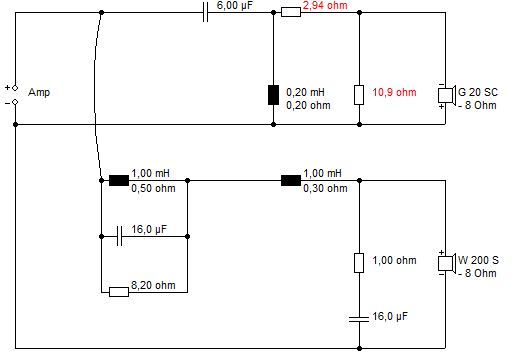
Until you build them, you really don't know. It's the hobby. But my experience is that people make this harder than it is.
Guide Dog Training - Mongrels - BBC Three - YouTube
"So my young Protege, you wish learn the ancient Art of crossovery..."
Wearisome measuring follows...
"WAIT. So really, all I need is ears!"
"Welcome aboard!"
Original circuit:
One of my more demented efforts:
And another one:
Until you build them, you really don't know. It's the hobby. But my experience is that people make this harder than it is.
Last edited:
Can you post the current crossover used with the morel? I can design a crossover and can try to optimise the parts (re-use what you have).
I personally wouldn't pair these to drivers as the 3rd and 5th order distortion will come through from the W22 in the midrange... maybe that's where your problem area is and you are blaming the tweeter?
In anycase - happy to help you.
I personally wouldn't pair these to drivers as the 3rd and 5th order distortion will come through from the W22 in the midrange... maybe that's where your problem area is and you are blaming the tweeter?
In anycase - happy to help you.
It is difficult to create a good crossover at the first try. You need valid measurement data (see what wintermute said some posts ago). And unfortunately the assumption that a "better" driver let you build a better speaker is false, as a customized crossover for inexpensive drivers can and will often outperform a generic crossover with high-end drivers.
IMHO you have two roads in front of you:
1) embark in the DIY route with the T35 tweeters. You need to buy measurement equipment (a calibrated mic is a must), learning how to use it, design a crossover suitable to your drivers, build and measure it. Measure the outcome is a key of the process. You also need a bunch of components for your tries (coils, caps, resistors)
2) buy the "correct" tweeters and build the TRYM. Fastest route to fully obtain what the drivers can offer you.
Both route are valid, but the first has a meaning if you want this to be a (repeatable) hobby. I had this first experience with inexpensive drivers, frankly starting with expensive ones is a hard project, if the outcome won't satisfy you it will be difficult to understand if you did something wrong.
Ralf
IMHO you have two roads in front of you:
1) embark in the DIY route with the T35 tweeters. You need to buy measurement equipment (a calibrated mic is a must), learning how to use it, design a crossover suitable to your drivers, build and measure it. Measure the outcome is a key of the process. You also need a bunch of components for your tries (coils, caps, resistors)
2) buy the "correct" tweeters and build the TRYM. Fastest route to fully obtain what the drivers can offer you.
Both route are valid, but the first has a meaning if you want this to be a (repeatable) hobby. I had this first experience with inexpensive drivers, frankly starting with expensive ones is a hard project, if the outcome won't satisfy you it will be difficult to understand if you did something wrong.
Ralf
- Status
- This old topic is closed. If you want to reopen this topic, contact a moderator using the "Report Post" button.
- Home
- Loudspeakers
- Multi-Way
- Crossover frequency and filter order advice sought
